Maintaining the grass in your soccer stadium is a key strategy for managing your budget and saving money. Proper care of the grass or turf can lead to significant financial benefits for yourself or the educational institution you represent.
While many people are familiar with basic lawn care, understanding advanced practices and techniques can maximize your investment. Here are ten effective methods for maintaining soccer field grass:
Choosing the Right Maintenance Approach
The initial five strategies focus on natural grass, while the remaining five are tailored for artificial soccer turfs. Reviewing both will help you determine the best approach and know when it might be time to switch between natural and synthetic options.
Understanding both natural grass and synthetic turf is essential for smart financial planning, especially in challenging economic times.
Table of Contents
ToggleStrategies for Maintaining Natural Stadium Grass
Using Grow Lights
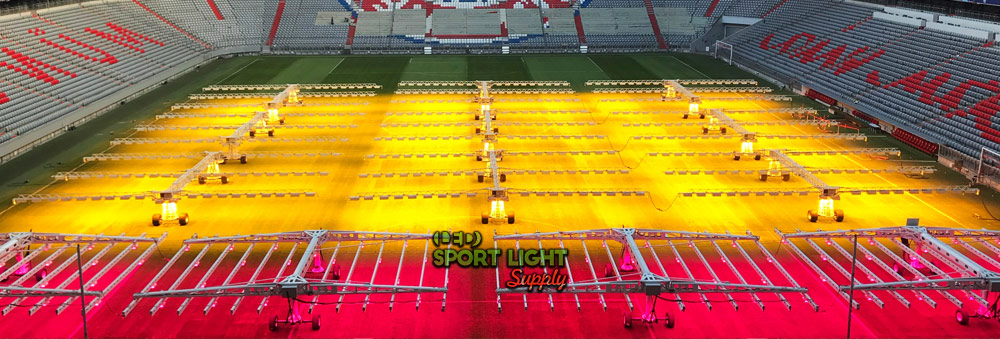
Grow lights are an essential tool for maintaining and enhancing the growth of natural turf in soccer stadiums. These professional systems are designed to improve grass growth by providing additional light that accelerates plant food synthesis, especially during colder seasons when natural light is insufficient.
The grow lights are typically mounted on a modular structure, allowing them to be easily transported across the field without causing damage due to their lightweight design. LED lights are often preferred for their efficiency and cost-effectiveness. However, if the stadium’s roofing creates prolonged shade, these lights can be adjusted or removed as needed.
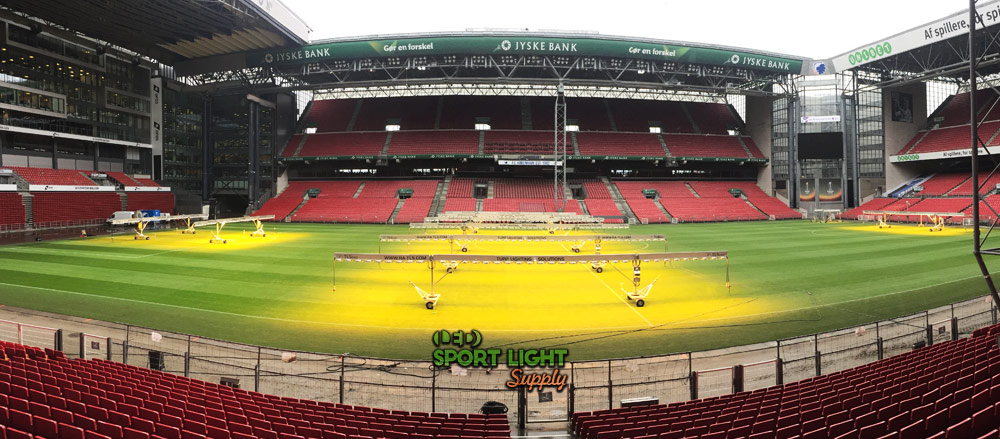
By establishing a proper lighting schedule, you can monitor and enhance the growth of your soccer field. Regular use of grow lights supports the development of a robust root system, enabling the grass to withstand heavy use and maintain its quality over time. Focus particularly on areas with high wear, such as the midfield lines and goal areas, to ensure a resilient playing surface for the players.
Mowing the Lawn Regularly
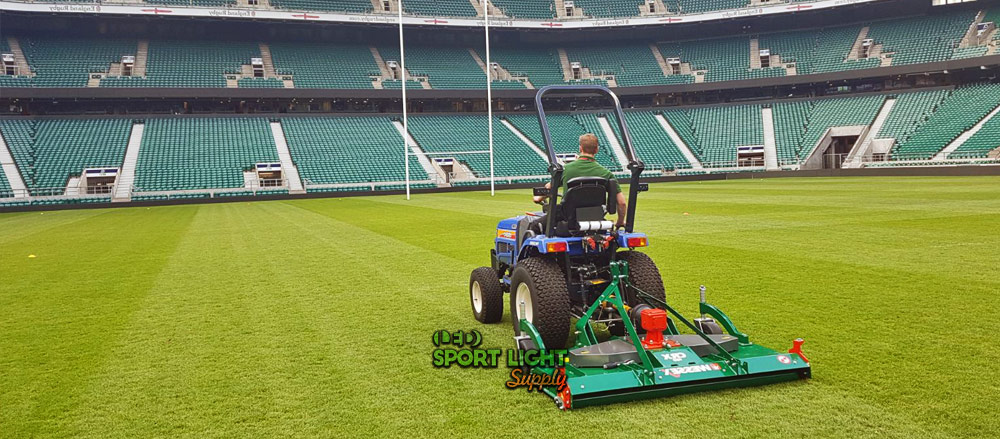
The frequency of mowing depends on the stadium’s location and the health of the soccer field. Ideally, only one-third of the leaf surface should be removed per mowing session. If more than one-third is cut, it indicates that the mowing schedule needs adjustment.
Maintain a yearly record of temperatures and grass growth to refine your mowing schedule. Regularly measure the height of the grass in a small section to determine if you need to increase the mowing frequency. Avoid excessive stress on the grass by adhering to the one-third rule, as cutting too much at once can disrupt gas exchange and affect grass health.
Grass types have specific height requirements for optimal growth. For example, Bermuda grass should be kept between 0.5 inches and 2.5 inches tall, while Fine fescue thrives between 1.5 and 3 inches. Kentucky bluegrass and Perennial ryegrass have ranges of 1 to 3.5 inches and 0.75 to 2.5 inches, respectively.
Proper mowing not only enhances the appearance of the field but also supports the grass’s ability to endure various weather conditions. Cold-season grasses such as Fine Fescue, Tall Fescue, Kentucky bluegrass, and Perennial ryegrass should be cut at appropriate heights to help them resist summer heat while maintaining their health and appearance.
Essential Steps for Grass Nutrition
Maintaining the health of your soccer field grass is akin to managing finances: it requires a solid foundation and ongoing care. Begin with high-quality topsoil, good seed, and regular watering to establish a strong base. Properly feeding the lawn and addressing weed issues as they arise are crucial for sustained growth and vitality.
In early spring, focus on fertilizing the field, but avoid overloading with fertilizer, as this can lead to excessive and unmanageable growth. Ideally, you should have applied fertilizer in the previous fall, providing the grass with nutrients to sustain it through the winter and into the spring. Liquid fertilizers are preferable in spring for their controlled application and ability to target specific areas.
Avoid applying excessive nitrogen, which can lead to rapid, uncontrolled growth and increased mowing frequency. Use additional fertilizer only if the pitch has been neglected or was not fertilized in the previous autumn. After the grass emerges from dormancy, gradually apply fertilizer throughout the summer and monitor growth to avoid overuse.
Be attentive to signs of senescence and areas with lime green spots. Fertilize these areas carefully, and check for weeds before applying additional nutrients.
Overseeding Bare Spots
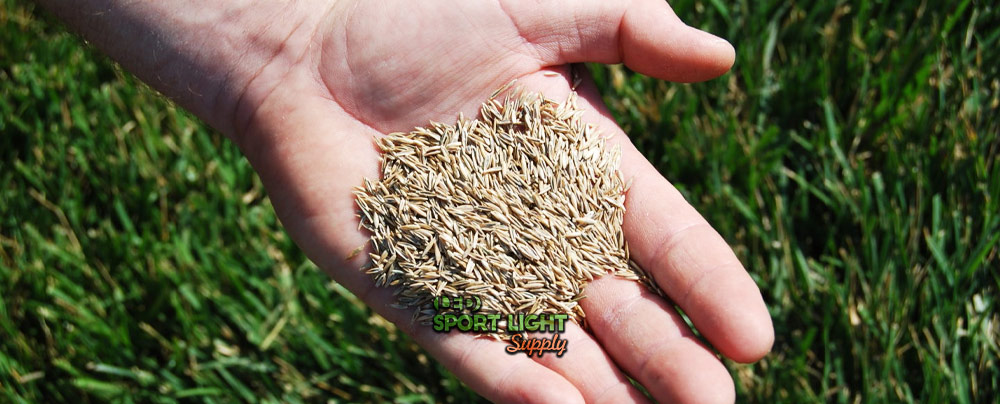
Overseeding is a valuable technique for improving the appearance and health of your soccer pitch. The process involves adding new grass seeds to existing turf to fill in bare spots and enhance the field’s overall quality.
Begin overseeding in September, or later in the fall for southern regions, and earlier in northern areas. Prior to overseeding, mow the grass as short as possible while adhering to the one-third rule. If needed, perform dethatching to remove dead organic material and prepare the soil for new seeds. This step is essential if the field shows signs of summer stress or fungus.
Utilize a dethatching machine or rake to remove excess thatch, ensuring a healthy environment for seed germination and growth.
Aeration for Improved Grass Health
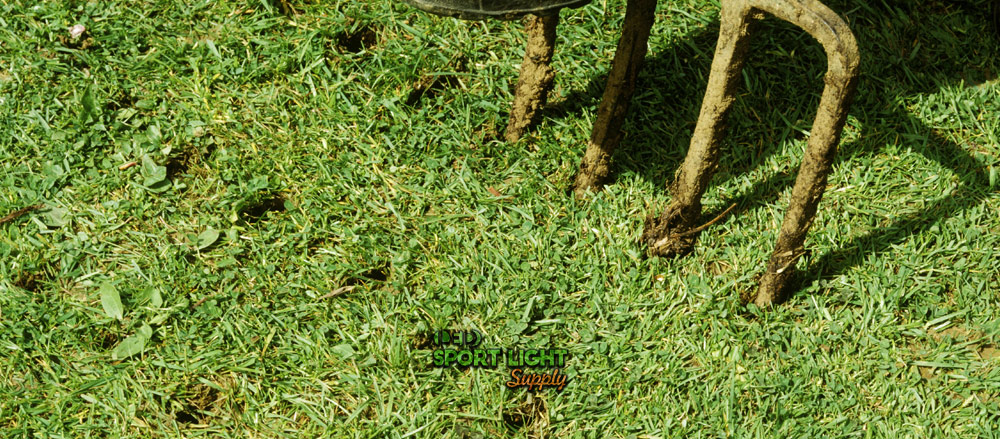
Aeration is a beneficial practice to enhance soil health and grass quality. It involves removing plugs of soil from the field to improve air circulation and nutrient absorption. This process helps reduce compaction and promotes the development of strong, deep roots.
While aeration is not strictly necessary for overseeding, it can significantly benefit the field, especially under heavy use from soccer play. The process creates small holes in the soil, allowing nutrients and air to reach the root zone more effectively.
To determine if aeration is needed, conduct a simple test with a screwdriver after summer. If the tool penetrates the soil easily, aeration may not be necessary. However, if you encounter resistance, core aeration should be performed to improve soil health and grass growth.
Strategies for Maintaining Artificial Stadium Turf
Removing Leaves and Debris
To ensure the longevity and appearance of artificial grass, regular maintenance is crucial. Routine cleaning involves removing leaves and debris to keep the pitch in optimal condition. A power broom is effective for most debris, but a professional cleaning solution can enhance the process.
For a thorough clean, use a sprayer attached to a hose to apply the cleaning solution across the entire field. Depending on the field’s usage, you may need specialized cleaners designed for artificial turf, which are often non-toxic and biodegradable, ensuring safety for players.
Periodic deep cleaning helps eliminate unpleasant odors and bacteria. A solution of chlorine and water can be used sparingly to disinfect and address mold issues, but always follow the manufacturer’s guidelines to avoid damage.
Applying Weed Killer
Even with a weed barrier installed, weeds can still affect your synthetic turf, especially in summer. Airborne weed pollen can lead to the growth of clover and other weeds. To manage this, promptly apply weed killer to any emerging patches.
Use a weed killer that is compatible with artificial grass and adhere to temperature guidelines to prevent harmful vaporization. Regular application helps maintain the turf’s aesthetics and prevents invasive weed growth.
Using a Plastic Snow Shovel During Winter
In winter, snow management is essential to keep the synthetic turf playable. Opt for plastic snow shovels or specialized equipment that does not damage the grass fibers. Avoid metal or heavy snowplows that could cause wear and tear.
Ensure that any machinery used has appropriate tires designed not to damage the synthetic grass. Radial tires, for instance, offer better performance and less risk of causing harm compared to traditional designs. Proper snow removal helps maintain the field’s usability for events and practices.
Consistent Turf Care
While synthetic turf does not require watering, it should be rinsed regularly to remove dirt and residues. Regular hosing helps keep the turf clean, especially in high-traffic areas where dirt and odors can accumulate.
Brush the synthetic grass weekly to prevent matting and maintain its appearance. Addressing any spills or odors promptly ensures that the turf remains fresh and hygienic for players. Professional turf care services can provide additional maintenance at a reasonable cost, ensuring high safety standards and optimal conditions for play.
Extending the Synthetic Turf Warranty
Extending the warranty on your synthetic turf can be a cost-effective measure to protect your investment. When purchasing artificial grass, inquire about extending the warranty to cover potential issues.
Test the product thoroughly before buying and consider high-quality options that offer robust warranties. Look for coverage that includes common problems such as drainage issues, heat damage, seam defects, lifted edges, UV discoloration, and incorrect installation. Quality materials and comprehensive warranties ensure durability and long-term satisfaction with your turf.
Why Maintaining Stadium Grass is Essential
Maintaining stadium grass is crucial for a variety of reasons, including financial benefits and player safety. Understanding the underlying motivations for upkeep can help you make informed decisions and set effective goals. Whether you are aiming to save money or enhance your stadium’s capabilities, maintaining your grass or synthetic field plays a key role.
Financial Benefits and Long-Term Goals
Proper lawn care and maintenance can lead to significant cost savings. By keeping your stadium grass in good condition, you can avoid costly repairs and replacements. Additionally, effective maintenance helps in budgeting and planning for future investments, such as expanding your sports venue or upgrading facilities.
For many stadium owners, managers, and athletic directors, saving money is a primary motivation. However, maintaining the grass should align with broader goals. For example, improving the quality of your sports arena can make it more attractive for hosting professional matches, which can, in turn, increase revenue through ticket sales, sponsorships, and broadcasting rights.
Enhancing Venue and Event Quality
Maintaining the grass or synthetic turf ensures that your field meets the standards required for high-level competitions. This can lead to opportunities to host more prestigious events, such as professional soccer matches or major tournaments. Achieving such milestones not only enhances the venue’s reputation but also helps in attracting more athletes, fans, and investors.
Player Safety and Field Performance
Regular maintenance is vital for player safety. Well-maintained grass reduces the risk of injuries caused by uneven surfaces or poor field conditions. Ensuring the field is in top shape contributes to a better playing experience and can help prevent injuries that might occur due to hazards on the field.
Financial and Personal Growth
Investing in the maintenance of your stadium grass can also lead to personal and financial growth. A well-kept facility increases its value and can provide financial returns through various channels, such as higher ticket prices and increased venue rental fees. Moreover, a successful stadium can serve as a stepping stone for further career opportunities or investments.
Benefits Overview
Here are some of the key benefits of maintaining your football field grass:
| Benefit | Description |
|---|---|
| Better tracking of expenses | A well-defined maintenance schedule helps in managing and tracking costs effectively. |
| Expansion opportunities | Proper upkeep can lead to opportunities to expand your sports venue and retire earlier. |
| Increased profitability | Improved field conditions enhance the attractiveness for broadcasting sports events. |
| Global networking and investment | Maintenance can help in building connections with investors and planning for international opportunities. |
| Enhanced safety | Regular care protects players, children, students, and all stadium users from potential hazards. |
| Protection of assets | Maintaining the field helps in preserving the main asset for sport management and operation. |
Conclusion
Maintaining stadium grass—whether natural or synthetic—is essential for both financial savings and player safety. Proper upkeep not only extends the lifespan of your field but also enhances the quality of play and venue attractiveness. By investing in regular maintenance, you can achieve significant cost savings, improve the playing experience, and open doors to higher-level events and opportunities. This proactive approach ensures that your sports facility remains a valuable asset, capable of meeting the demands of athletes, fans, and future expansions.
